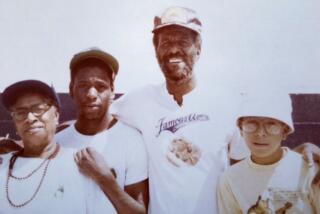Ownership of Wham-O Spins Into Chinese Hands
- Share via
Chinese investors couldn’t buy a U.S. oil company or the maker of Maytag appliances, but now a Hong Kong group will be able to claim a real American icon: Wham-O Inc., the maker of Frisbee, Hula-Hoop, Silly String and Slip ‘N Slide toys.
Privately held Wham-O said Thursday that it had been acquired by toy distributor Cornerstone Overseas Investments Ltd. for an undisclosed amount.
Wham-O, headquartered for most of its 58 years in San Gabriel before it moved to Emeryville in Northern California, has bounced around more than a Super Ball -- another of Wham-O’s famed inventions.
As the company changes hands yet again -- Mattel held it for a time in the 1990s -- its new owners promise to use their factories in China to deliver the products to new markets around the world.
“This is a very exciting deal because of the strong brands and the expansion opportunities,” said James Rybakoff, chief executive of Akin Bay Co., the investment company that advised Cornerstone. “American retro-legacy brand names is what is in, and the Chinese love them.”
The deal also is an example of the new Chinese purchasing power -- evidenced last year by bids for Unocal Corp. and Maytag Corp., although those ultimately failed.
In the past, American companies outsourced their production or created joint ventures with Chinese partners that handled manufacturing and distribution. Now, the Chinese are increasingly interested in buying established businesses and running the operations themselves.
“They want to keep the management and creativity and marketing in the U.S., but they want to have the manufacturing and back-office operations” in China, Rybakoff said.
Wham-O, with scant overseas distribution, was a perfect target.
Cornerstone plans to move Wham-O’s production to its larger Chinese factories to take advantage of economies of scale. Cornerstone can then sell Hula-Hoops and Frisbees to stores in the 54 countries where it already is doing business.
What’s more, Cornerstone Chief Executive Jeff Hsieh owns a chain of 400 toy stores across China, making immediate distribution in Asia even easier.
Cornerstone would not disclose the purchase price but said it was an all-cash deal for less than the $80 million Wham-O sought when it was on the auction block in 2004. Cornerstone said it would keep most of Wham-O’s 300 or so employees for now but had not made a decision for the long term.
“We’ve been expecting a sale of Wham-O for a long time because the company has been struggling for quite a while,” said Jim Silver, editor of Toy Wishes magazine. “Their Frisbee sales have been shrinking; in the water slide business, they’ve lost market share to competition; and the majority of the hoop business is now with Maui Toys.”
Wham-O got its name from the sound made by its original product, a slingshot, introduced in 1948 by two USC graduates, Rich Knerr and Arthur “Spud” Melin.
But it wasn’t until the late 1950s that Wham-O burst into American pop culture, with its introduction of the Frisbee and the Hula-Hoop.
The business was never huge -- sales last year were about $80 million -- and the founders long ago sold out, although not before seeing the Hula-Hoop enshrined in the Smithsonian Institution.
*
(BEGIN TEXT OF INFOBOX)
From slingshots to Silly String
1948: Two childhood friends and USC graduates, Rich Knerr and Arthur “Spud” Melin, start a mail-order business out of the Knerr family garage selling 75-cent slingshots. They call the company Wham-O, after the sound made by their slingshots.
* 1955: After a chance beach encounter with inventor Fred Morrison, Knerr and Melin buy the rights to his plastic flying disc, the Pluto Platter.
* 1957: Wham-O markets the Pluto Platter for the first time. A year later, the company renames it the Frisbee, and sales take off.
* 1958: Inspired by bamboo rings that Australian children twirl in exercise class, Wham-O produces a plastic version it calls the Hula-Hoop. A toy craze ensues: 20 million sell within four months of the introduction.
* 1961: Wham-O’s latest product, the Slip ‘N Slide, slips off shelves and slides into thousands of backyards.
* 1965: Taking advantage of a chemical engineer’s accidental discovery of a plastic product that bounces uncontrollably, Wham-O introduces the Super Ball. Eight million sell in six months.
* 1972: The company introduces Silly String, claiming each can contains a quarter-mile of the sticky string.
* 1982: Knerr and Melin retire, selling Wham-O to Kransco of San Francisco for $12 million.
* 1994: Mattel buys Kransco and closes Wham-O’s San Gabriel warehouse.
* 1997: Mattel sells its Wham-O products to a new Wham-O Inc., based in San Francisco.
* 2006: Cornerstone Overseas Investments of Hong Kong buys Wham-O.
Researched by Scott J. Wilson
More to Read
Inside the business of entertainment
The Wide Shot brings you news, analysis and insights on everything from streaming wars to production — and what it all means for the future.
You may occasionally receive promotional content from the Los Angeles Times.










